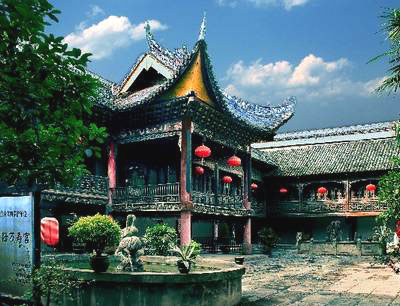| Tools: Save | Print | E-mail | Most Read |
| Shiqian Treasure in a Small Town |
| Adjust font size: |
There's no easy way to reach Shiqian County Town. Quite reasonably, few tourists brave the long-distance bus from
Travel has historically been so difficult that even the provincial tourism bureau pays scant attention to the area. Local legend lays the blame on a long-ago regional leader with a shaky grasp of development economics. He allegedly opposed the building of a railway on the grounds that "it would make the price of eggs go up." Change cannot be far away. A modern highway smoothed my ride into a tidy new main street much like those in small towns all over Shiqian lies in a deep valley, strung along both banks of the None but the oldest residents remember this arrangement. Today the public bathhouse by the riverside is divided into men's and women's sections, while up the hill is a single complex housing private tubs that cost from 20 yuan to 40 yuan an hour. It's tremendously popular with locals¡ªstreams of wet-haired bathers accompanied me back into town along the ancient street that runs parallel with the river. This street is an attraction in itself. Its irregular wooden buildings look run-down by comparison with the new pedestrian shopping area and neat main street, but on market days it fills with peasant traders from the mountain villages and the old shop fronts come to life. It feels like the whole town crams into this narrow space to finger goods, haggle prices and enjoy the outrageous patter of various "snake-oil" salesmen. Without the crowds, it's only ten minutes' walk along the old street to the magnificent Ming Dynasty (1368-1644) stone bridge across the Longchuan. From there, the history hunter turns away from the river and strolls five minutes into the new town, where Shiqian's most remarkable treasures are preserved.
Wanshougong was built in 1403 as a kind of clubhouse for wealthy immigrants from Next door to Wanshougong is a similar structure that belonged to immigrants from A much later group of immigrants was responsible for the lovely church just a couple of hundred meters south of Wanshougong. In the nineteenth century, The nuns' home was used as a temporary residence by the communist General He Long in 1936; it is now a museum dedicated to the communist Red Army, while the upstairs of the priest's residence house bears remains of graffiti the Red soldiers painted on the walls. Although there are doubts about whether or not it's genuine, this is a quite unique collection that illuminates the revolutionaries' overriding concerns at the time: taxes, imperialism and the Japanese invasion. The church itself, however, has been restored to the congregation. On Sundays, a handful of old people and children gathers to hear the Shanghai-trained priest deliver an idiosyncratic sermon peppered with traditional Chinese sayings and quotes from Deng Xiaoping and Karl Marx. A short walk south stands a temple to a very different faith: Confucianism. This was built in 1413 and has recently been given a fresh lick of paint and a teahouse to encourage visitors. By the time I settled down with a glass of green tea, I had almost completed a circuit of the town, walked no more than an hour, but spent an entire day. It's a rich and restful experience, as long as you forget about the bus ride. (btmbeijing May 10, 2007)
|
| Tools: Save | Print | E-mail | Most Read |
 |
| Related Stories |
|
|
Product Directory China Search |
Country Search Hot Buys |

